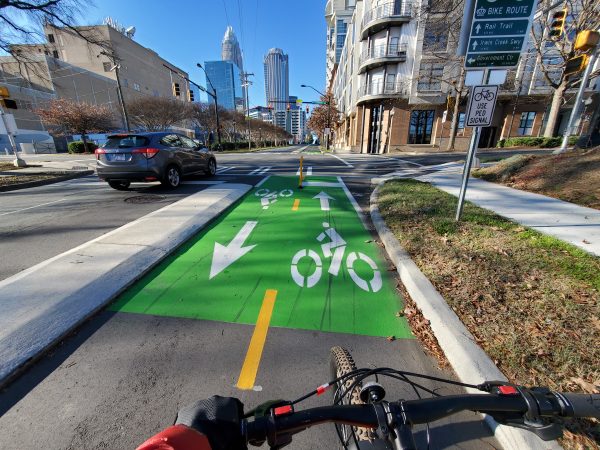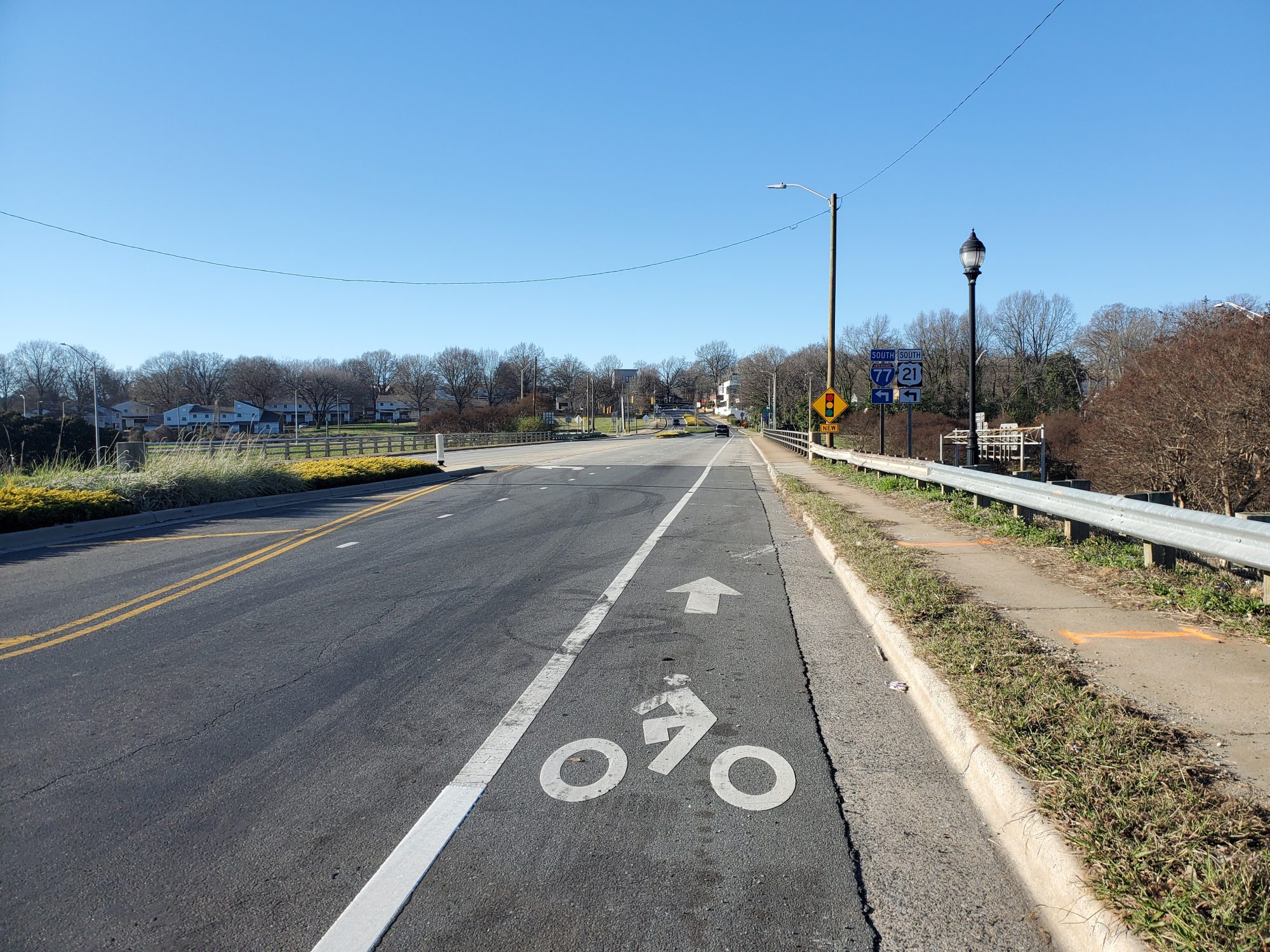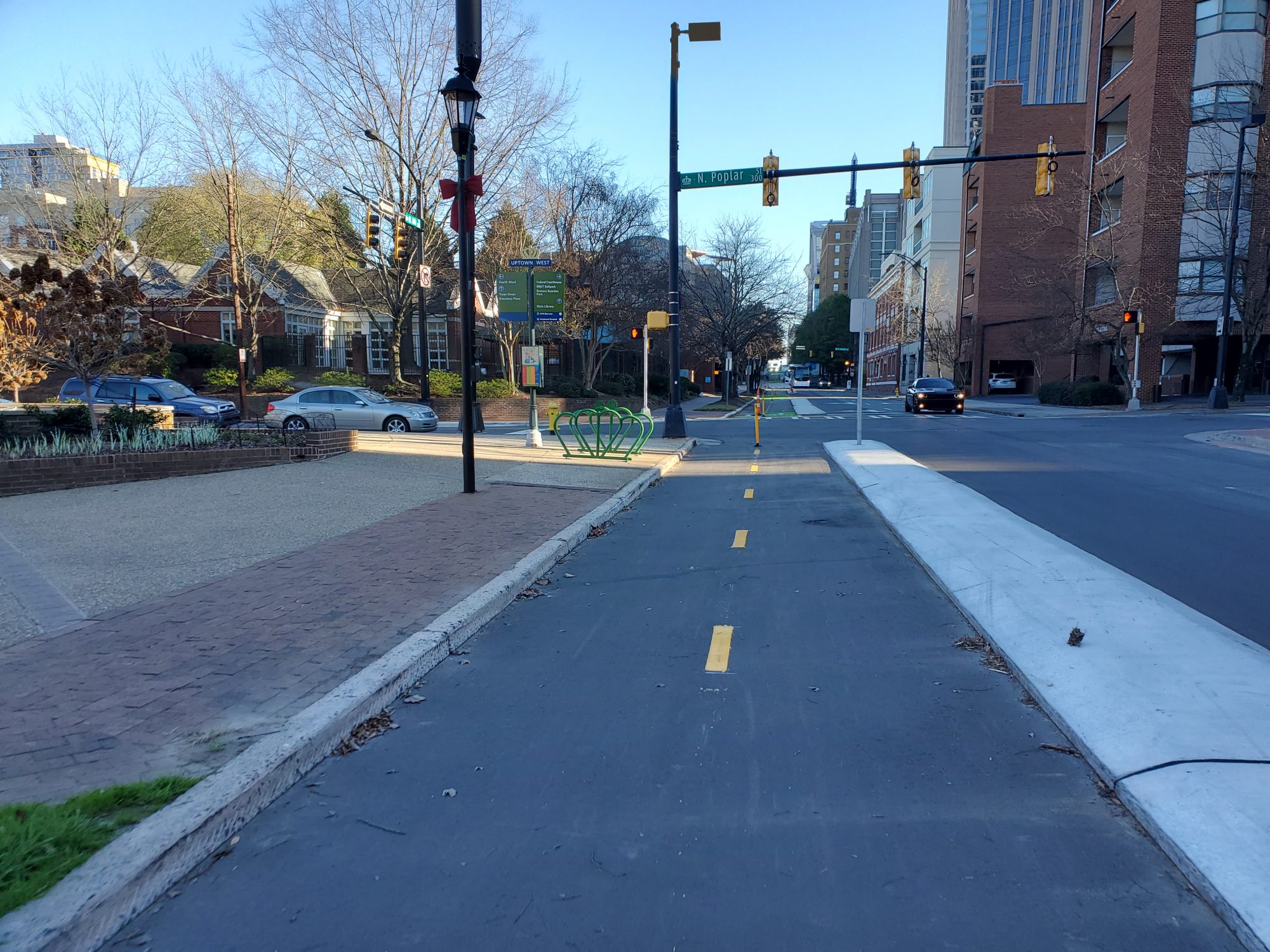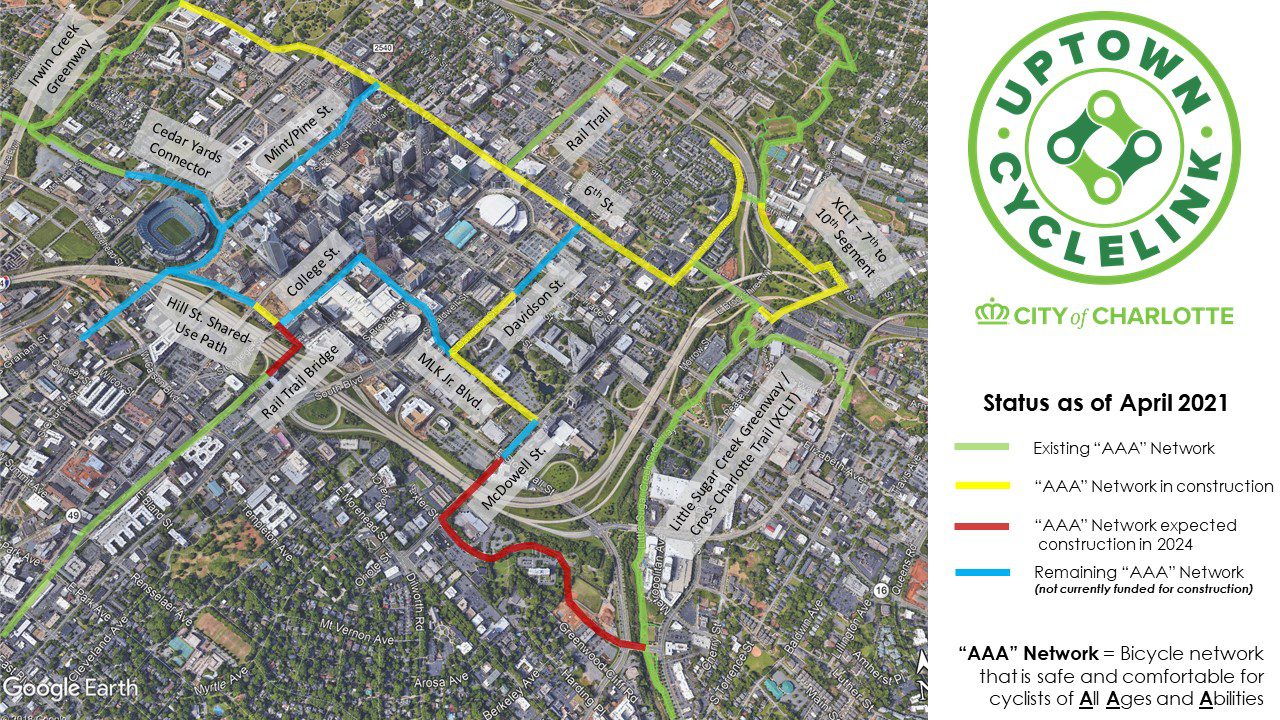Finally, biking in uptown without fear

Pedaling through uptown last week alongside cars and pedestrians, I felt something that I’ve rarely felt before on city streets: Relaxed.
That’s because I was riding not in lanes of traffic or in a tiny, painted “bike lane,” but in a full-sized, two-way, striped and painted lane for bicycles, separated from cars by a concrete curb and plastic bollards.
Building on a 2019 pilot project that ran for less than a mile along 6th Street, Charlotte’s first true network of protected bike lanes is nearing completion in uptown. Officially called the CycleLink, the new protected bike lanes run east-west on 5th and 6th streets to connect Irwin Creek and Little Sugar Creek greenways. A protected bike lane runs up McDowell Street to connect uptown to a greenway branch running north towards NoDa.
The project was set for completion by the end of 2021, but (as is common) construction delays cropped up. Some new pedestrian crossing signals aren’t fully installed, and workers were still touching up the paint last week. But the new lanes are mostly done, and riders are out and about using them (I skipped a short portion of the lanes that was blocked off with cones and caution tape, but the criss-cross of tire tracks showed many riders aren’t doing the same).
As Charlotte gets ready to debut its newest transportation project, here are five thoughts about what the future of bicycling could look like in Charlotte — and what we still need to work on.
-
Riding is believing — they really work. I typically ride my bike at least three times a week, but usually on local greenways and mountain bike trails. Riding on busy city streets with cars whizzing by? That’s usually a “nope” for me. The protection afforded by those strips of white paint denoting “bike lanes” on most city streets seems laughable.
The protected bike lanes are a different story. You still have to watch for cars turning and pulling out of driveways, but the feeling of safety offered by having enough space and a real, physical barrier between yourself and traffic is immediate and immense. I felt almost as relaxed and safe as I typically do riding McAlpine Creek Greenway near my house. When the lanes peter out, as they do on the west side of uptown, it almost feels like an insult to be dumped back on Charlotte’s traditional “bike lanes.”
As soon as I reached the western end of my ride and cycled along Trade Street for a little while on a narrow, painted bike lane, a large SUV veered right and crossed over the line in front of me. The concrete curbs I’d been protected by a few hundred feet behind me would have prevented that — and the painted line would have easily let a bicyclist be sideswiped if anyone had been on that particular spot at the same time.

A traditional Charlotte bike lane, with only a painted stripe to separate riders from traffic. Photo: Ely Portillo -
Cost and time will be issues. The uptown CycleLink has been a long time coming. A report outlining the possible routes for protected bike lanes was released in 2017, after four years of planning and a 2016 petition by Sustain Charlotte with more than 4,000 signatures. So, all told, we’re closing in on a decade first, modest bike lanes are just nearing completion. If Charlotte wants to meet its stated goal of becoming a “true city of bikes,” future protected lanes need to be built faster.
[See a timeline of the protected bike lanes here]
As for the cost, that’s a little trickier. Surely many will see the price tag of $7.15 million and think “Wait, that’s a lot for some concrete medians and plastic dividers!” But the project also includes new crossing signals, relocated utilities and, of course, lots of planning time. Future projects might well be cheaper, now that Charlotte has a better idea of how to build protected bike lanes.
And there’s another way to look at it: The protected bike lanes in uptown cost less than 5% of the streetcar’s second phase (which clocked in at $150 million). Plus, the protected bike lanes don’t have the ongoing operational cost — and well-documented operational challenges — that transit projects like the streetcar have run into. It’s a lot easier to run a network of protected bike lanes than a network of street cars.
The “Charlotte Moves” plan would earmark 80% of its $13.5 billion spending for transit projects and 20% for roads, greenways, sidewalks and bike lanes. The exact funding breakdown isn’t yet clear, but even a small fraction of that spending could help Charlotte dramatically expand its bicycle infrastructure (of course, that plan hinges on a new, 1-cent sales tax whose future is very much up in the air).

One of the new, protected bicycle lanes. Photo: Ely Portillo -
The payoff for investments in bicycle infrastructure are compounding. If the CycleLink were a single protected bike lane that ran along 5th and 6th streets, my reaction would probably be more along the lines of “big whoop.” But by connecting Irwin Creek, Stewart Creek and Little Sugar Creek greenways, plus the Rail Trail and Cordelia Park, the CycleLink brings together more than a dozen miles of off-street bicycle paths. Future projects, such as the Rail Trail bridge to South End and linking up the north and south portions of Little Sugar Creek Greenway, will only add to that.
Put it all together, and you start to get a network that functions as more than a disconnected series of recreational opportunities. People in neighborhoods west of uptown have an easy and safe way to bike to a restaurant in Belmont. People southeast of uptown can bike to work at a bank and be on a protected lane the entire way, not just for portions of the trip. And this network links to the Blue Line light rail. Charlotte is edging closer to a real, functional network of safe, protected options for biking around its core neighborhoods.
While it’s not realistic to think Charlotte is going to build a full-fledged network of protected bike lanes out to the burbs where I live anytime soon (nor that most people want to bike 10 miles each way to uptown on a regular basis), the city could look at buildings protected bike lanes around dense nodes in the suburbs — for example, Waverly and Rea Farms in southeast Charlotte, or the commercial core of Ballantyne — to connect more people and neighborhoods.

-
Yes, but not everyone is going to hop on their bikes and pedal off into the sunset. OK, I’m an enthusiastic bicyclist, but I’m also a realist who lives in suburbia and drives his kids to school most mornings. Only about 0.2% of Charlotteans commute daily to work via bike, according to Charlotte’s 2020 State of Mobility report (I admit that I myself drove every day pre-pandemic).
We’re clearly a long way from becoming Copenhagen, where half of all trips to work and school occur via bikes. But the uptown protected bike lanes at least show that it’s possible — even in a city as sprawling and auto-centric as Charlotte — to move a little bit closer to that direction. Most people are not going to feel comfortable biking in the road, with traffic — but if there’s a safe, well-built alternative, more Charlotteans are likely to give it a try. Just don’t expect a dramatic change overnight. -
Improved bicycle infrastructure can benefit everyone. Discussions about improving infrastructure for bicyclists often get cast in an adversarial fashion. Adding a bike lane? You’re taking a lane away from cars. Making it easier to bike somewhere? Great, now pedestrians have to watch out for bikers whizzing by.
But a trip on the protected uptown bicycle lanes shows this doesn’t have to be the case. Electric scooters are using the CycleLink, along with bicyclists — which means they’re not dodging pedestrians on the sidewalk. Drivers don’t have to worry about knocking over a bicyclist trying to squeeze by just inches to their right in the same lane. And bicyclists, of course, don’t have to spend their ride dodging car doors, swerving SUVs and jittery pedestrians.
What about the lost travel lane for cars? While my pair of visits to the CycleLink (one on a weekday afternoon during rush hour) don’t constitute a comprehensive traffic audit, there were no visible traffic problems along 5th or 6th streets. I suspect the reason for that has to do with both the fact the these relatively small, one-way streets weren’t particularly traffic-choked most days anyway (I suspect you’d see a lot more problems at rush hour if you took an outbound lane of Providence Road), as well as the presence of plenty of alternative ways to get around. According to the city, there are 34 lanes in total for cars running east-west across uptown, so taking one away for a bike lane just isn’t going to have an incredibly dramatic impact. Of course, we’re still in the pandemic, so all bets might be off if and when rush hour returns in full force.
So is Charlotte’s future a Dutch-style nirvana of people biking everywhere? With a city sprawling over more than 300 square miles, I suspect not. But the new protected bicycle lanes — and the miles of greenways they connect — give us a glimpse of what a more bike-friendly future could look like.
This story was originally published in Transit Time, a collaborative newsletter produced by UNC Charlotte’s Urban Institute, WFAE and The Charlotte Ledger.


